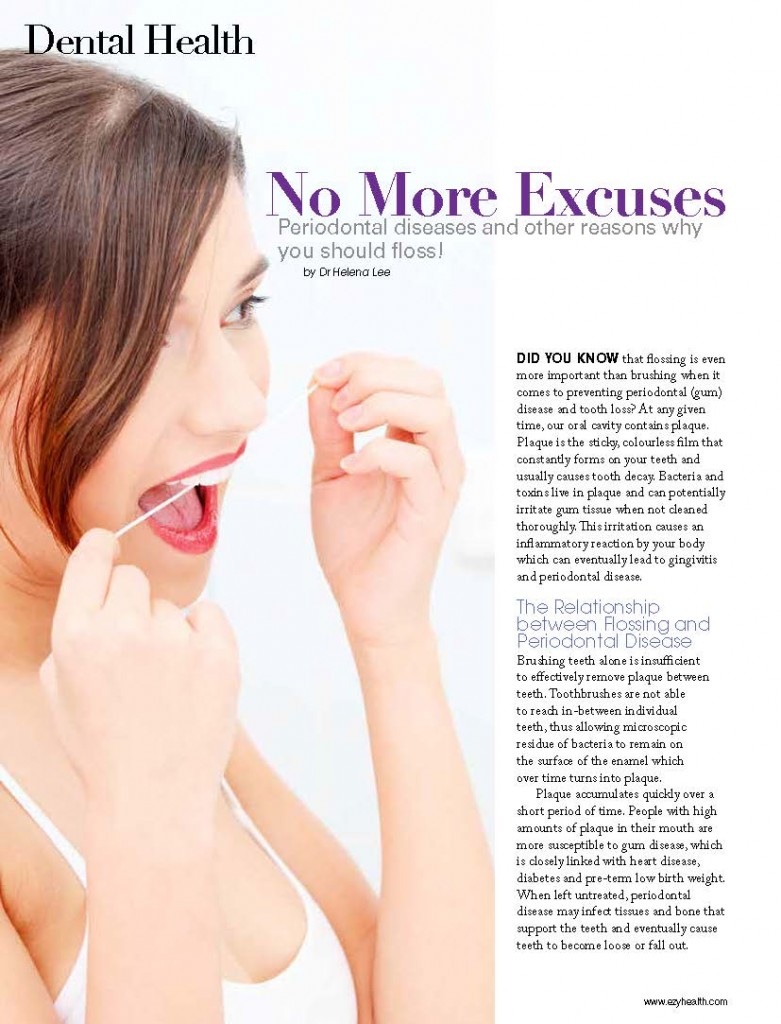 This article first appeared in the February 2014 issue of Ezyhealth magazine. We have reproduced it for the information of those of you who missed it when it was published.
This article first appeared in the February 2014 issue of Ezyhealth magazine. We have reproduced it for the information of those of you who missed it when it was published.
DID YOU KNOW that flossing is even more important than brushing when it comes to preventing periodontal (gum) disease and tooth loss? At any given time, our oral cavity contains plaque. Plaque is the sticky, colourless film that constantly forms on your teeth and usually causes tooth decay. Bacteria and toxins live in plaque and can potentially irritate gum tissue when not cleaned thoroughly. This irritation causes an inflammatory reaction by your body which can eventually lead to gingivitis and periodontal disease.
The Relationship between Flossing and Periodontal Disease
Brushing teeth alone is insufficient to effectively remove plaque between teeth. Toothbrushes are not able to reach in-between individual teeth, thus allowing microscopic residue of bacteria to remain on the surface of the enamel which over time turns into plaque.
Plaque accumulates quickly over a short period of time. People with high amounts of plaque in their mouth are more susceptible to gum disease, which is closely linked with heart disease, diabetes and pre-term low birth weight. When left untreated, periodontal disease may infect tissues and bone that support the teeth and eventually cause teeth to become loose or fall out.
Flossing and brushing your teeth twice daily are the best ways to ensure that your teeth are free from plaque, gingivitis and periodontal disease.
Who is At Risk?
Some people may be more susceptible to periodontal disease due to the following factors:
Dental Braces
Due to the nature of metal braces, thorough oral hygiene is more difficult. Dental braces wearers will be more prone to develop tartar, gingivitis or even demineralisation of tooth enamel. If left untreated, they can turn into a more serious oral health issues and possibly cause longer treatment time. Brushing your teeth after every meal is highly recommended. You will need to complement this with flossing or interdental brushing using a floss thread or interdental brush.
Medical Conditions
Some medical conditions such as diabetes or heart disease, as well as certain medicines, increase the risk of heart disease. Research has shown that people with diabetes are at higher risk of developing periodontal disease as they are more prone to contracting infections. When diabetes is poorly controlled, high sugar levels in the mouth fluids will encourage the growth of bacteria that cause gum disease.
Diet Choices
Unhealthy snacks such as fries or sodas are bad food choices. Fries are starchy foods which are metabolised into acids that eat into tooth enamel. Snacking on these between meals also increases the chance of accumulating plaque when immediate tooth brushing is not available after eating them.
It is important to cultivate a habit of flossing from a young age because the damage done can be costly.
Flossing is recommended at least once at the end of the day, and ideally, after every meal. If light flossing constantly results in bleeding gums, it could be a sign of gum disease, and it is always best to consult a dentist or gum specialist (periodontist).
Daily flossing would remove plaque before it hardens to form more adherent calculus (tartar), which will then need professional dental scaling to remove.
Diligent flossing combined with good brushing techniques and regular dental check-ups will go a long way to help ensure that your teeth stay bright and healthy for a lifetime.
No More Excuses; Flossing is Not Rocket Science!
- Choose floss that is smooth or “waxed” so that it is easier to ease between teeth.
- Take a strand of floss between 35cm to 40 cm long.
- Facing a mirror, twine both ends of the floss around the middle finger of both hands several times until you have a short portion in front of you.
- Control only a small (2cm) section between the thumbs and index fingers of both hands and ease the floss between two adjacent teeth.
- Slide the floss along the length of the crown of the tooth.
- Pull the floss into a c-shape and slip it between the gums and the tooth gently. Do not be too vigorous with the floss, especially when pulling it straight across the papilla (the pointed part of the gums between teeth) as it can cut into the gums, causing soreness.
- Repeat the same action with the c-shape facing the adjacent tooth.

Dr Helena Lee is a Dental Specialist in Periodontics with Specialist Dental Group®, Singapore. She is also an Adjunct Lecturer with the National University of Singapore. Dr Lee has a special interest in dental implants, gingival plastic surgery, and tissue grafting. For more information, visit www.specialistdentalgroup.com





